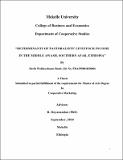| dc.description.abstract | Ethiopia is among the first ten nations in the world with respect to the livestock population.
However, the benefit obtained from the sector is low compared to other African countries and the
world standard. The economic gain for the pastoralists, who predominantly live on rearing
livestock for their livelihood, is below the national average. Therefore, identifying the major
determinant factors affecting income from livestock is needed to device appropriate development
interventions to improve livestock income and thereby living standard of pastoralists.
This study was conducted in Amibara and Gewane woredas of Afar Region with major objective
of analyzing determinant factors affecting pastoralists’ livestock income. A random sampling
procedure is used to select 10 PAs and 100 sample respondents. Primary data are collected from
sample respondents and focussed groups through personal interview and discussions using
structured interview schedule and checklists, respectively. Data on demographic and
socioeconomic characteristics of the sample respondents are presented and discussed using
various tools of descriptive statistics. The survey result reveals that 66% of sample respondents
receive ALSI below the average livestock income [less than ETHB 10,839.40] in the study area.
Among four major sources of household income identified for the study area, livestock income
contributes 73.30% of the total household income followed by employment (18.09%), crops
cultivation (5.28%) and land rentals (3.33%).
Multiple Regression Model is used to identify variables capable of affecting the livestock income.
The model results reveal that among 15 explanatory variables included in the model, 6 are found
to be significant at the conventional levels of significance. Those variables which are important
determinants of livestock income are a) total livestock holding, b) access to credit, c) availability
of grazing land, d) risk of predators, e) livestock breed type and f) livestock mobility. Improving
livestock production and productivity, organizing pastoralists into cooperatives, market oriented
livestock production, improving pastoralists’ access to and participation in the markets, managing
associated risks of mobility and proper management and control of the invasive species from
grazing lands are the recommendations forwarded. | en_GB |


